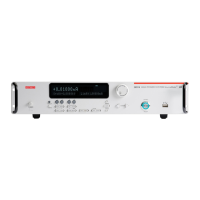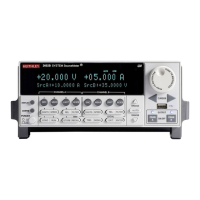6-3
SECTION 6
High Power Tests
file ‘KI2602Example_High_Voltage.tsp’ after downloading it
to your PC.
If your computer is currently connected to the Internet, you
can click on this link to begin downloading: http://www.
keithley.com/data?asset=50966.
Install a device (Power FET, LED array, etc.) in the appropriate 6.
transistor socket of the test fixture.
Now, we must send the code to the instrument. The simplest 7.
method is to right-click in the open script window of TSB,
and select ‘Run as TSP file’. This will compile the code and
place it in the volatile run-time memory of the instrument.
To store the program in non-volatile memory, see the “TSP
Programming Fundamentals” section of the Series 2600 Refer-
ence Manual.
Once the code has been placed in the instrument run-time 8.
memory, we can run it at any time simply by calling the func-
tion ‘
RunHighVoltage(sourcev, points)
’, where
sourcei
is the desired voltage value and
points
is the
number of voltage measurements.
In the program ‘9. KI2602Example_High_Voltage.tsp’, the func-
tion
RunHighVoltage(sourcev,points)
is created.
sourcev
• represents the voltage value delivered to the
DUT Note that the actual voltage value programmed for
each SMU is half the sourcev value.
points
• represents the number of voltage measurements
acquired
If you wanted to source 80V total to the DUT and collect 100
voltage measurements, you would send
RunHighVoltage(80, 100)
to the instrument.
The sources will be enabled, and the voltage source and cur-10.
rent measurements will be executed.
Once the measurements have been completed, the data will 11.
be presented in the Instrument Console window of TSB.
6.2.3 Program 16 Description
After the SMUs are returned to default conditions, SMUA is con-
figured as follows:
Source V•
1A compliance, autorange•
1 NPLC integration rate•
sourcev
• : DUT voltage
points
• : Number of points to measure
Next, SMUB is set up to operate in the following manner:
Source I•
1A, autorange•
sourcev
• : DUT voltage
After the instrument is set up, the outputs are zeroed and enabled.
Each SMU performs a DC voltage source and SMUA begins to
measure the current. When the data collection has reached the
desired number of points, the outputs are disabled and the cur-
rent data is printed to the Instrument Console of TSB.
Warning:
If either SMU reaches a compliance state, the instru-
ment, device, or both could be damaged. To avoid
this, set the compliance value to the maximum for
your instrument and avoid shorting the SMUs when
in Voltage Source mode.

